Restoring the land to restore the sea

June 4, 2024 Benjamin Jones Chief Conservation Officer This year’s World Environment Day campaign focuses on land restoration, under the slogan “Our land. Our future. We are #GenerationRestoration.” Loss and degradation of coastal marine ecosystems, compromise the delivery of important ecosystem services to human society. Yet turning the tide on these losses and working towards a net gain in biodiversity is a challenge, not least because coastal marine ecosystems are exposed to threats occurring both in the ocean and on land. Land use change, through conversion of native terrestrial vegetation for agriculture, urbanization, and industry increases runoff and sedimentation, causing degradation of coastal ecosystems such as seagrass meadows. Swathes of evidence from across the globe reveal that anthropogenic activities from the land are some of the largest drivers of seagrass loss. For example, research from the Philippines has revealed that land use is more important than marine protection for tropical seagrass condition, and our own research has revealed the agricultural drivers of seagrass degradation across the British Isles. Yet for the most part, conservation prioritisation for coastal ecosystems is traditionally centred around protecting intact habitats from ocean-based stressors (e.g., fishing). If we are to conserve seagrass, we need to look beyond the ocean, and to the land. And this year’s World Environment Day is a key reminder of that. To conserve seagrass, should we be protecting habitat on land, protecting habitat in the ocean, restoring habitat on land, restoring habitat in the ocean, or a mixture of these actions? Answering this question is extremely difficult, not least when data is absent, histories of change are blurred, priorities for monitoring and management change and the nature and extent of threats to seagrass are unknown. In these instances, we believe that it is vital to understand which threats local stakeholders observe or perceive as being most persistent. Interweaving indigenous and local knowledge, and other expert witness knowledge as alternative data sources, is key. Our land. Our future. Seagrass meadows in the Wakatobi National Park (WNP), Indonesia are exploited for their rich fish and invertebrate communities – faunal communities that provide food security and livelihoods across the National Parks islands. Yet, with a growing population, the area of seagrass habitat is decreasing, and plant species composition and health is declining. Working with our local partner, FORKANI, and after a series of focus groups with local stakeholders, it seemed clear that the issue and threat they felt was most dominant, was sedimentation; the removal of mangroves and primarily forest areas had lessened the ability for land to absorb and store water. Built on indigenous and local knowledge, FORKANI, in collaboration with Project Seagrass, developed an incentives programme designed to provide fruit trees to farmers and landowners to facilitate stabilisation of river banks and reduce sediment deposition to the coast and at the same time improve the continually worsening problem of water storage. Now, over 5000 trees have been planted along riverbanks across the National Park by FORKANI, as well as school groups and government ministers. Photo: Nusi, a member of FORKANI, tends to trees in a nursery. Photo: Teenagers and school groups also took part in tree planting.
Understanding Wales past oceans to inspire their biodiverse future
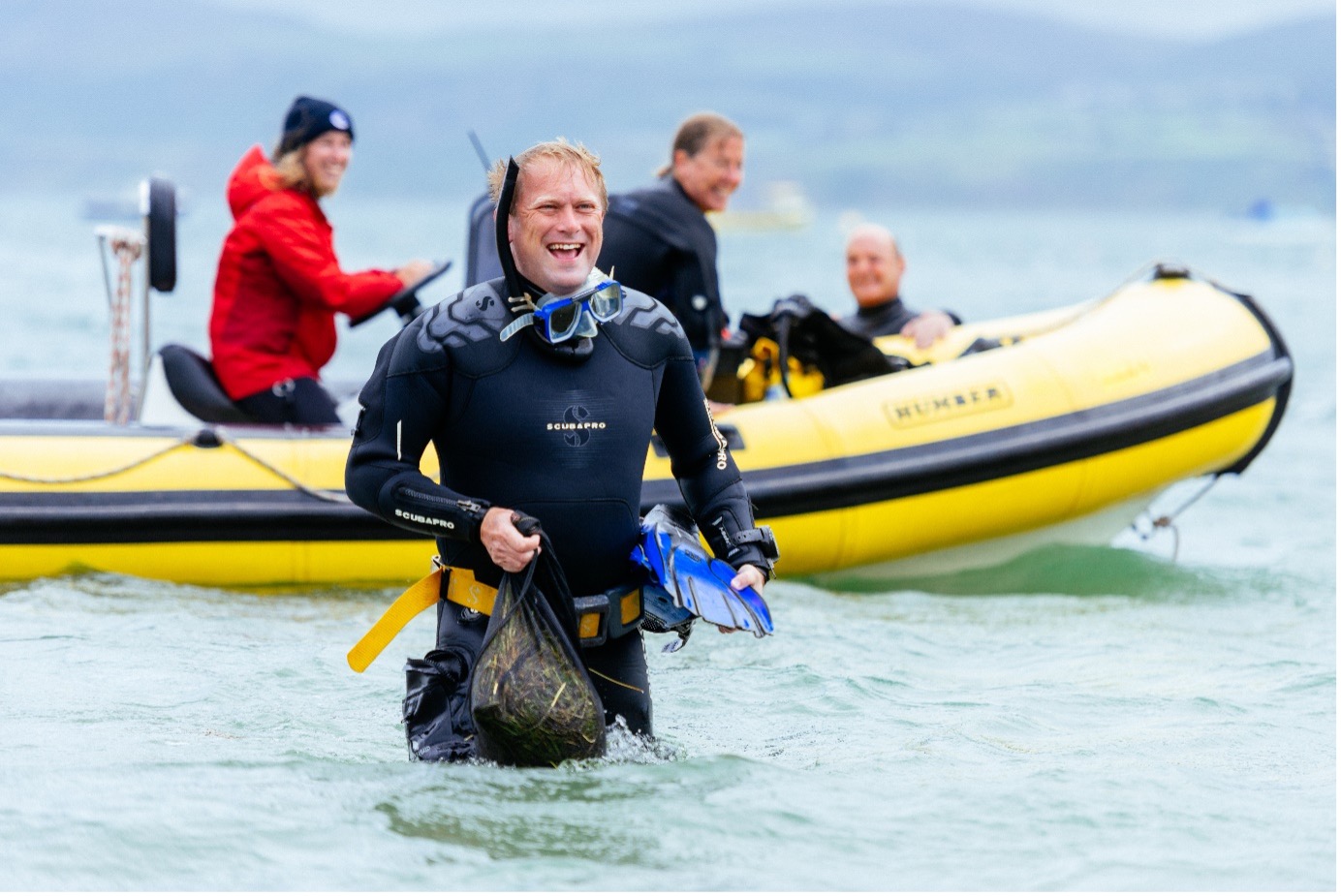
Dr Richard Unsworth, Project Seagrass and Swansea University The seas around Wales have so much potential. They offer rich biodiversity hidden within productive lush habitats such as kelp forests, salt marshes and seagrass meadows. Life in these waters can be so ingenious that it bioengineers its own environment. Out of seemingly nothing, reefs and seagrass appear that can protect our coast and filter our water. Deepwater horse mussels that bring barren depths to life. All these habitats are teaming with life. We have Mearl beds too that are like the coral reefs of the Atlantic. We have whales, we have dolphins and we can even see turtles feeding on summertime jellyfish blooms. We also have sharks and seabirds a plenty. We potentially have it all. The Celtic seas around Wales used to support the food supply and livelihoods of the people of our nation, but this is no longer the case. Scratching the surface of history and it doesn’t take much to see this glorious past that we’ve allowed to be washed away. Our industrial past of mining and heavy industry as well as our overfishing and gross mismanagement of land have left a terrible decimation. Visiting Penllyn earlier this summer I was reminded of the Three herrings, the symbol of Nefyn – Nefyn herrings used to be sold as a high value product to the wealthy in Manchester and there used to be an abundant Fishery for the now mostly extinct crayfish. But these fisheries have long since disappeared. In South Wales, 1000’s of boats going out daily into Swansea bay collected Oysters a plenty, these provided jobs, food and a way of life. And now all that is left of this abundance of sea life in Oystermouth and the Mumbles are stories and tales. Wales is left with folklore rather than food. It’s also fascinating to consider what habitats and species would have populated our South Wales coastline before we build ports, reclaimed vast swaths of the intertidal and flooded coastal embayments with barrages. These areas were prime for biodiverse habitats. Sat in a Laugharne Pub soaking up the atmosphere of Dylan Thomas you see pictures from the 1930’s of a 3m long sea monster proudly held by a group of men. This picture isn’t from Cambodia on one of Jeremy Wades ‘ Sea Monster’ series, but it’s a sturgeon caught in the Taf Estuary in what’s now the Carmarthen bay and rivers special area of conservation. Our coastal environments were once full of such diverse and abundant life that is now largely locally extinct. A short trip onto the delightful town Tenby, or as it was locally known ‘Dinbych Y Pysgod’ or ‘Fort of the fishes’ you readily see signs everywhere of historically productive fisheries that are now largely lifeless. Fishermen on the beach get excited when they catch a small plaice, and my son out fishing with his grandparents fails to even catch the odd Mackeral. Hardly the abundance that led to the development of a thriving town and furnished the wallets of the monks of Caldey. Just how did we as a nation let this decline happen. How can we possibly pass this travesty of an environment to the next generation without doing something drastic? Moving west from Tenby we find the remnants of a once vast and abundant fishing community on the shores of the Cleddau. Yes, the waters of Milford Haven were over fished, but we also allowed heavy industry, poor land management and inappropriate farming activity to destroy the very habitats that had sat there for 10’s of thousands of years and supported the fisheries. We’ve allowed this to continue with the ongoing pollution of the sea from the activities of the land. Milford Haven waterway was once home to Wales last major Mearl bed, but that gave way to the pursuit of ever bigger infrastructure for oil and gas. As we heat the waters of the Cleddau with power station outfalls and subject the area to ever-increasing nutrient loads, the delicate seagrass continues to struggle as it increasingly respires without enough energy to keep going. As catchments and coasts degrade the place becomes ever more awash with mobile sand and mud particles further damaging the environment. Divers in the 1970’s tell of clear waters at the Neyland bridge in Milford Haven at sites that would now be too plagued with sediment and are too murky to even consider for a dive. Wales, what have we done? How did this happen? Now is not the time for a blame game, we need action instead. The Welsh Government has declared a biodiversity emergency as well a climate emergency. Time is of the essence and there is much to do. We need to take significant action to enable our marine environment to once again support our communities, our livelihoods, our well-being and most of all our planetary support. Last week we saw the launch of the Welsh Government Biodiversity Deep Dive recommendations of how the nation will start to repair its depleted habitats and associated biodiversity. A key part of these recommendations are a series of urgent actions required for the marine environment. I was part of the working group of biodiversity experts tasked with creating these recommendations. It’s fantastic to see the fresh impetus for the government to take action on establishing marine protected areas and fulfil their election promise to invest in the restoration of seagrass and salt marsh. Politics aside, I was proud to be working with a minister and government who want to do the right thing, who want to actively reverse biodiversity loss and who understand the precarious environmental tight rope that we’re currently walking and the history of political promises but limited change. What we now need is action, we need the Welsh Government on the back of a terrible political climate from central government to push their prosed recommendations and agenda forward. We need the Marine Protected Area plans to move out from their covers and
Biodiversity is essential to planetary health
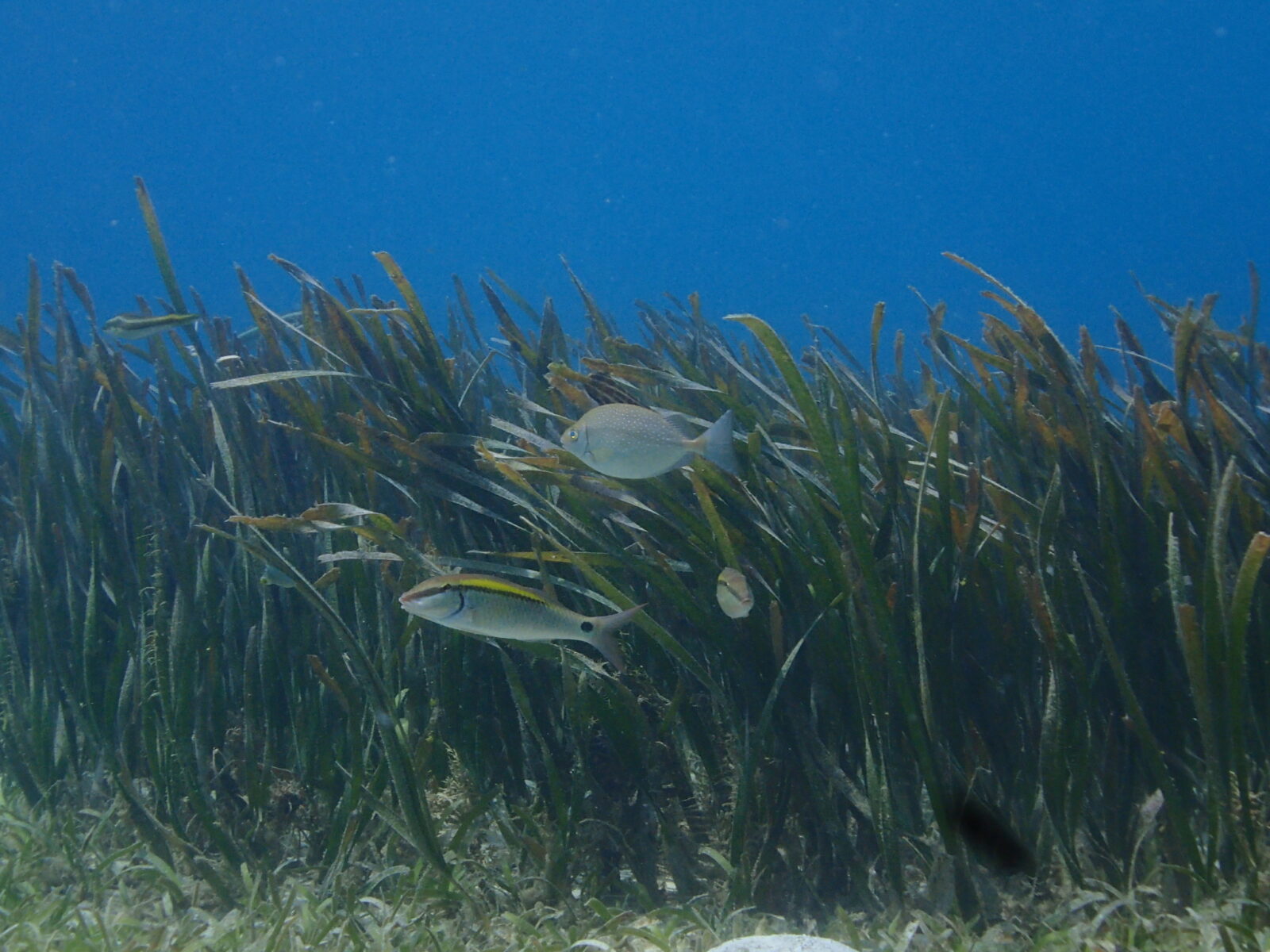
[vc_row type=”in_container” full_screen_row_position=”middle” scene_position=”center” text_color=”dark” text_align=”left” overlay_strength=”0.3″ shape_divider_position=”bottom” bg_image_animation=”none”][vc_column column_padding=”no-extra-padding” column_padding_position=”all” background_color_opacity=”1″ background_hover_color_opacity=”1″ column_link_target=”_self” column_shadow=”none” column_border_radius=”none” width=”1/1″ tablet_width_inherit=”default” tablet_text_alignment=”default” phone_text_alignment=”default” column_border_width=”none” column_border_style=”solid” bg_image_animation=”none”][vc_column_text]A few weeks ago part one of the UN Biodiversity Conference (aka COP15) took place in Kunming, China. Whilst all eyes are on the UN Climate Conference set to take place in Glasgow, UK next week, we must not forget the vital role that biodiversity plays in our planets health. Seagrass habitats are vital for supporting ocean biodiversity. Biodiversity loss threatens both people and planet, placing pressure on our health, economy, and food security. We are currently losing biodiversity at an unprecedented rate. The 2020 Living Planet Report estimated that between 1970 and 2016 the global populations of vertebrates declined by an average of 68%. Land-use change for food production is one of the biggest threats to biodiversity. Humans have changed the face of the earth. We have polluted our oceans and destroyed more than 85% of our wetlands. In a bid to reduce biodiversity loss and stem the destruction of ecosystems by 2020, the Aichi biodiversity targets were outlined and adopted in 2010 at COP10. More than a decade later, not one of those targets were met. We have to realise that humans are not set apart from nature. We are intrinsically linked with nature and the threat to biodiversity is a direct threat to humanity. Our future is dependent on the protection and revival of healthy ecosystems. Biodiversity conservation is a non-negotiable if we are to live on healthy planet with food and economic security. We must stop working against nature. Encouraging biodiversity to flourish is vital for people and planet. COP15 has set the stage for an effective global biodiversity framework to halt the loss of biodiversity and bring life back to our planet. Parties to the Convention on Biological Diversity (CBD) have adopted the Kunming declaration whereby they have committed to negotiate an effective post-2020 global framework that can bend the curve of biodiversity loss. What this looks like will be agreed upon when part 2 of the conference resumes in May 2022. Additionally, parties to the CBD have committed to upping the spend on biodiversity protection and restoration. The Government of China established a 1.5 billion-yuan (c.$233 million) Kunming Biodiversity Fund and the EU have promised to double its biodiversity fund. Parties to the CBD must now commit to an effective framework that puts nature on a path to recovery by 2030. We must all realise the role that healthy, biodiverse ecosystems play in our day-to-day lives and put pressure on our governments to recognise and support nature-based solutions to the climate and biodiversity crises.[/vc_column_text][/vc_column][/vc_row]
A Life On Our Planet
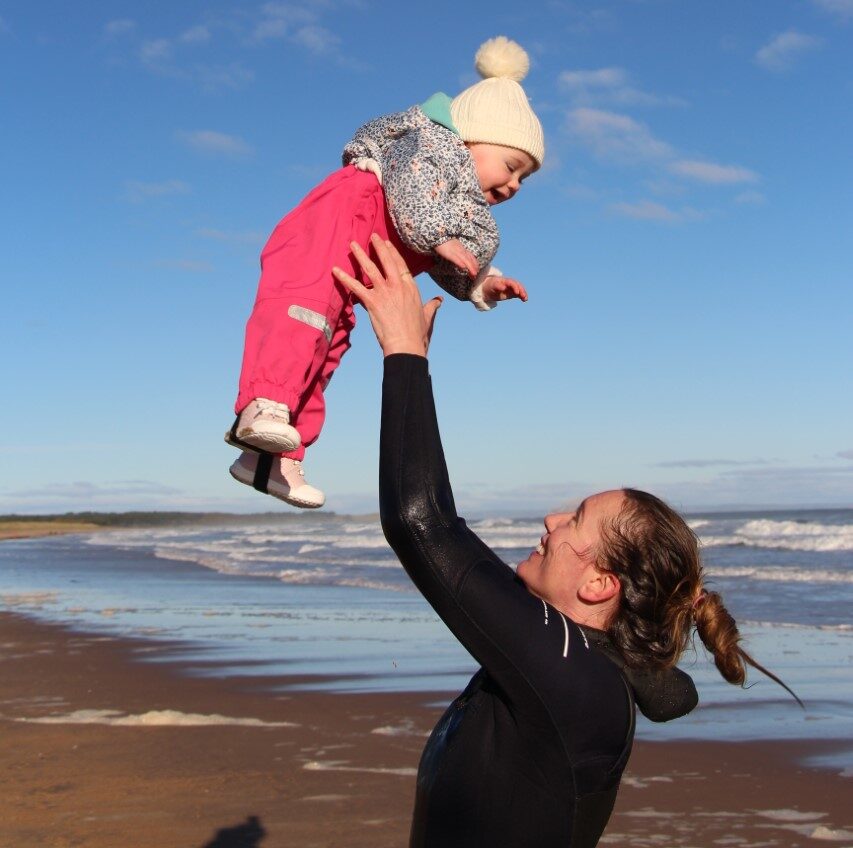
[vc_row type=”in_container” full_screen_row_position=”middle” scene_position=”center” text_color=”dark” text_align=”left” overlay_strength=”0.3″ shape_divider_position=”bottom” bg_image_animation=”none”][vc_column column_padding=”no-extra-padding” column_padding_position=”all” background_color_opacity=”1″ background_hover_color_opacity=”1″ column_link_target=”_self” column_shadow=”none” column_border_radius=”none” width=”1/1″ tablet_width_inherit=”default” tablet_text_alignment=”default” phone_text_alignment=”default” column_border_width=”none” column_border_style=”solid” bg_image_animation=”none”][vc_column_text]“I’ve had an extraordinary life. It’s only now that I appreciate how extraordinary. As a young man, I felt I was out there in the wild, experiencing the untouched natural world – but it was an illusion. The tragedy of our time has been happening all around us, barely noticeable from day to day – the loss of our planet’s wild places, its biodiversity. I have been witness to this decline. A Life on Our Planet is my witness statement, and my vision for the future. It is the story of how we came to make this, our greatest mistake – and how, if we act now, we can yet put it right. We have one final chance to create the perfect home for ourselves and restore the wonderful world we inherited. All we need is the will do so.” -Sir David Attenborough I imagine that by now a fair few of you reading this blog will have seen (or read) A Life On Our Planet; the‘ Witness Statement’ of Sir David Attenborough. If you haven’t, then I would absolutely encourage you to watch it. In fact do that NOW, you can come back to this blog later… If you were feeling anything like me, I was struggling to bring myself to watch the film. Against the background of COVID-19, the perpetual isolation from family and friends, the chronic lack of sleep from my early days of parenting and the harrowing reports I read daily relating to the triple crises of climate, biodiversity and pollution then quite frankly I felt I just didn’t have it in me to sit through some beautifully shot sequences of humanity trashing the planet! But I did sit down to watch it… and I am so very glad I did. Did I sit through a horror show? Well yes… But did it depress me? Well no… If anything the last 30 minutes of the film re-energised me. I needed a ‘pick me up’ and this film was it. If you are reading this blog, then chances are you already know that there has never been a more urgent need to restore damaged ecosystems than now, and I’m not just talking about seagrass ecosystems, but ALL ecosystems. It’s time to revive our planet. #Generation Restoration So here’s my CALL TO ACTION, head over to UNEP’s website NOW and join the #GenerationRestorationmovement today. There has never been a more urgent need to restore damaged ecosystems than now. Ecosystems support all life on Earth. The healthier our ecosystems are, the healthier the planet – and its people. The UN Decade on Ecosystem Restoration aims to prevent, halt and reverse the degradation of ecosystems on every continent and in every ocean. It can help to end poverty, combat climate change and prevent a mass extinction. However, the decade will only succeed if everyone plays a part. So join the movement today! 30km2 by 2030 As a team of interdisciplinary scientists, the work of Project Seagrass crosses the boundaries of both environmental conservation and social action. For seven years we have worked on the ground with coastal communities, both in the UK and internationally. If the last seven years has taught us anything at Project Seagrass, it’s that achieving our mission begins with how we build our team and how we work together. And now we need to work together more than ever: “At Project Seagrass, we are aiming to restore 30km2 of seagrass across the UK by 2030.” Whether you call it ‘rewilding’ or ‘restoration ecology’ the end point is the same. We need to put habitat back and quickly. Or as sir David said: “We have one final chance to create the perfect home for ourselves and restore the wonderful world we inherited. All we need is the will do so.” So to both UNEP and Sir David please know we are ‘all in’ with #GenerationRestoration, and after watching A Life On Our Planet, I am sure you will be too. Stay safe x RJ[/vc_column_text][/vc_column][/vc_row]
New life and new hope

Ah, the long awaited bank holiday weekend is almost here, but this time the circumstances are more than a little unusual. Instead of heading to the beach we will be staying at home, not just to look after ourselves but to support our NHS and it’s amazing staff. Easter is a time to celebrate Spring, it’s the time of year when everything in nature is changing and promising new life and new hope. However you celebrate, I think we can all agree it’s a pretty eggciting time! One of the iconic images we associate with Spring are eggs! Eggs, wonderful aren’t they? From hen eggs to chocolate eggs you’d think you’ve seen it all, well what about cuttlefish eggs? Ooo want to know more? Eggcellent! Why don’t you check out this 2016 blog post from our Director Ben, I think you’ll agree it’s worth getting eggcited about! Eve
The Isolated Conservationist

You are not alone! We are all having to take a pause from our chaotic lives in the midst of the COVID-19 pandemic. We must support our health care services and the incredible frontline workers by staying at home. Our ocean optimism and motivation to protect our planet does not stop for a lockdown. There are plenty of things that you can do from the safety of your home. Here are just a few ideas! Spring Clean! Perhaps you have some books, clothes or games you don’t want anymore? Staying at home is the perfect opportunity to have a big clear out. Once you’ve decluttered sell it at a car boot sale (when it’s safe to do so!). The money could then be used to catch a train to explore your nearest seagrass meadow or donate it to a conservation project, such as Project Seagrass. With the critical economic situation arising from COVID-19, it’s likely that many companies will have to take large budget cuts reducing what they can donate to small charities. Include your car in the clean-up- a lighter car uses less fuel! An Eco Makeover! Whilst having a spring clean try and identify products that could be switched for more eco-friendly ones- anything that goes down your drain or is chucked away will influence nature! Maybe switching cleaning products or try making your own?! How about making your own cosmetics such as shampoo bars or deodorant? Instead of buying new, maybe there’s an upcycling project you’ve always meant to do or get creative with handmade birthday presents. Why not try making eco-bricks or turning down the temperature of your washing machine? Seagrass Spotter! Take the extra time on your hands as an opportunity to go back through old holiday and beach snaps, there maybe some seagrass ones that could be uploaded to Seagrass Spotter to help build a global map of seagrass meadows. Encourage others to do the same! There are lots more citizen science projects you can get involved with like counting seabirds from your sofa. Plant Trees! For most working from home involves heavy internet use, so switch your search engine to ecosia and you’ll replant a forest in no time! Although Ecosia has had to reduce its tree planting during the pandemic, it plans to make up for lost time once safe to do so. Creative Conservationist! We have plenty of educational resources on the Project Seagrass website and shall be releasing more throughout social distancing. Check out our YouTube channel or our activities book. Maybe whilst you’re creating a rainbow coloured crab, you’ll have an eureka moment on other ways to Save Seagrass! This is also a chance to get artsy- maybe pick up those long forgotten paints for an underwater scene? Or work on those graphic design skills to make a seagrass awareness poster! Maybe you fancy yourself as a nature inspired poet or author? Eat for our seas! Enjoy having the time to try new things in the kitchen! Cutting down on your meat consumption is an easy way to help our earth. With less demand for meat comes less intensive farming, reducing the amount of excess nutrients from animal waste running in to our sea. The nutrients cause algal blooms which smother the seagrass, stopping sunlight reaching it for photosynthesis. Veggie grub also has a much lower carbon footprint. One of our favourite quick and easy comfort foods is roasted sweet potato and cauliflower tacos, you could even do a virtual taco night with friends! This recipe can easily be adapted to whatever’s left in the fridge- some peppers, onions or broccoli, maybe even mix in some leftovers from previous meals. Reducing food waste saves you money, takes pressure off our supply chains and helps protect our oceans- it’s a win all round! We’d love to hear of other ways people are keeping green, pop us a message and stay in touch whilst we’re all keeping distant. Best fishes, Evie!
Oceans Festival 2019
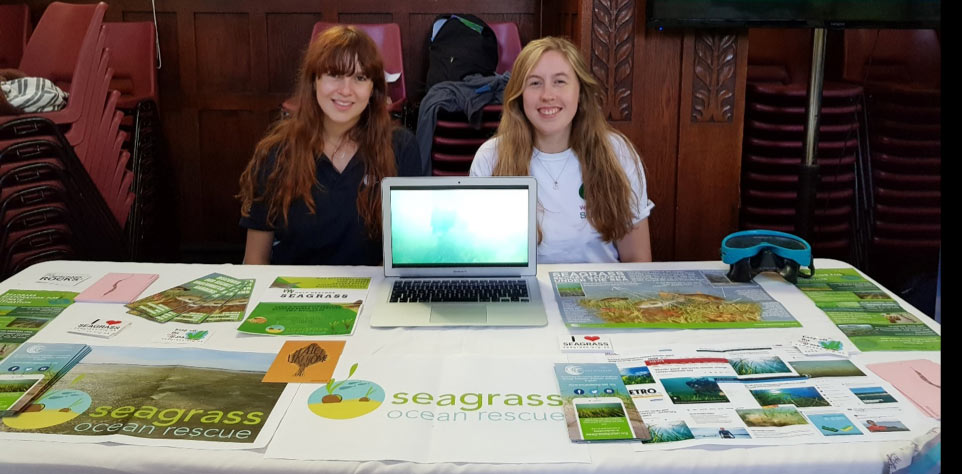
Oceans Festival was a day to celebrate work being carried out by scientists, educators, volunteers, artists and many more. There was a variety of stands all sharing the same passion for our oceans. With stalls selling sustainable and plastic free items to beautiful artwork of marine mammals as well as yummy vegan food there was something for everyone. There was a variety of stands all sharing the same passion for our oceans. Matt Brierley started the talks off on his new documentary he has been filming on the shark trade in the UK. It was shocking to find out that spiny dogfish which is critically endangered in the northern Atlantic is majority eaten in our fish and chip shops. These female sharks take 12 years to reach sexual maturity and has one of the longest gestation periods of any vertebrate, up to 2 years! Aside from this, illegal species are being brought into London fish markets, such as a juvenile scalloped hammerhead which is critically endangered and listed on CITES. It was terrifying to find out this happening in the UK. To move forward Matt wants “shark” to be labelled in fish and chips shops rather than the many other names it is given. This will make people more aware on what they are actually eating! A shocking fact I learnt at Scotland basking shark talk was that these sharks are consuming 440g of plastic every hour! There was a huge range of talks given from Lizzie Daly, Blue Ventures, Manta Trust and the Wave Project. This charity helps children who have had difficulties in their life and teaches them how to surf as a form of therapy. This massively helps build their confidence people, even changes the lives of these young people. This charity emphases how our oceans are used for a huge variety of purposes. To end the talks Andy Reid from Fins attached shared his involved with the charity and shared the legacy of Rob Stewart. This really touched me as when I was so inspired by Rob and his team growing up and how motivated he was to do everything he possibly can to save sharks and raise awareness of what is happening in the shark finning industry. His legacy carries on and with a new research vessel called Sharkwater which is traveling the globe to collect valuable marine data. On the stand it was great to hear such positive feedback from people about the project and to educate people about the importance of these incredible underwater plants. As well as seeing people wanting to get involved with the work being carried out by Project Seagrass. Overall there was a great sense of ocean optimism that spread across the festival, with people who are making a difference and to save our blue planet. Hopefully there will be more brilliant events like these. Thank you Oceans Festival 2019 for having us, and to everyone who volunteered. It was very fulfilling and enjoyable day! Thank you for reading. Issy Inman
Global fisheries threatened by loss of seagrass

Seafood consumption is both a love and a necessity for hundreds of millions of people all across the world. And the supply of seafood is a key part of maintaining food security for the whole planet. But as demand for seafood is increasing, stocks of wild fish and invertebrates (such as mussels and prawns) are declining. A major problem is that policies and plans designed to ensure the sustainability of our fisheries almost exclusively target fishing activity. But we also need to protect the critical habitats that these fisheries also depend on. Most species that are fished require more than one habitat to complete their lifecycles. For example Atlantic cod (Gadus morhua) spends its adult life shoaling in deep water, but juveniles require more stable habitat where they can hide such as seagrass meadows. So, if we want to manage stocks for sustainability, it is essential to protect the supporting habitats of targeted species. Seagrass meadows are a critical habitat supporting biodiversity and in turn the productivity of the world’s fisheries. Seagrass meadows are not only suitable for juvenile fish but also for larger fish of different species. As seagrass meadows occur in shallow, clear waters, they are an easily exploitable fishing habitat. Today, we published the first quantitative global evidence on the significant roles that seagrasses play in world fisheries . Seagrass as nursery grounds: provide a safer, less exposed, environment for eggs to be laid and young animals to find food and protection from predators as they grow. This includes commercial species such as tiger prawns, conch, Atlantic cod and white spotted spinefoot. In fact, one-fifth of the world’s most landed fish — including Atlantic Cod and Walleye Pollock benefit from the persistence of extensive seagrass meadows. Seagrass as a fishing area: it is not just large scale fishing industries that benefit from the presence of seagrass meadows. They are an easily accessible fishing ground used by small scale artisanal and subsistence fisheries around the world. Seagrass gleaning: seagrass is also essential habitat for gleaning activity, fishing for invertebrates such as sea cucumbers in water that is shallow enough to walk in. This is often done by women and children, and provides a source of essential protein and income for some of the most vulnerable people in tropical coastal communities. It is a common and increasingly visible activity, but it is not usually included in fishery statistics and rarely considered in resource management strategies. Seagrass supports other fisheries: seagrass also provides trophic support to other fisheries. They do this by creating expansive areas rich in fauna, from which there are vast quantities of living material, organic matter and associated animal biomass that supports other fisheries. Seagrasses also promote the health of connected habitats (like coral reefs), and have the capacity to support whole food webs in deep sea fisheries. Threats to seagrass, fisheries and food security: the coastal distribution of seagrass means that it is vulnerable to a multitude of land and sea derived threats. These include land runoff, coastal development, boating activity and trawling. On a global scale, seagrass is rapidly declining and when seagrass is lost associated fisheries and their stocks are likely to become compromised with profound and negative economic consequences. Seagrass meadows support global fisheries production Pdf Supporting policy and action is needed now! The importance of seagrass meadows for fisheries productivity and hence food security is not reflected by the policies currently in place. Urgent action is needed if we want to continue enjoying the benefits that healthy and productive seagrass meadows provide. Fisheries management must be broadened from just targeting fishing activity to also targeting the habitats on which fisheries depend. Awareness of the role of seagrass in global fisheries production, and associated food security, must be central to policy, and major manageable threats to seagrass, such as declining water quality, must be dealt with. Action is urgently needed to protect the worlds seagrass meadows if we are to continue to enjoy the benefits they provide.
International Women’s Day 2018: A call to #PressforProgress in recognising the role of women in fisheries
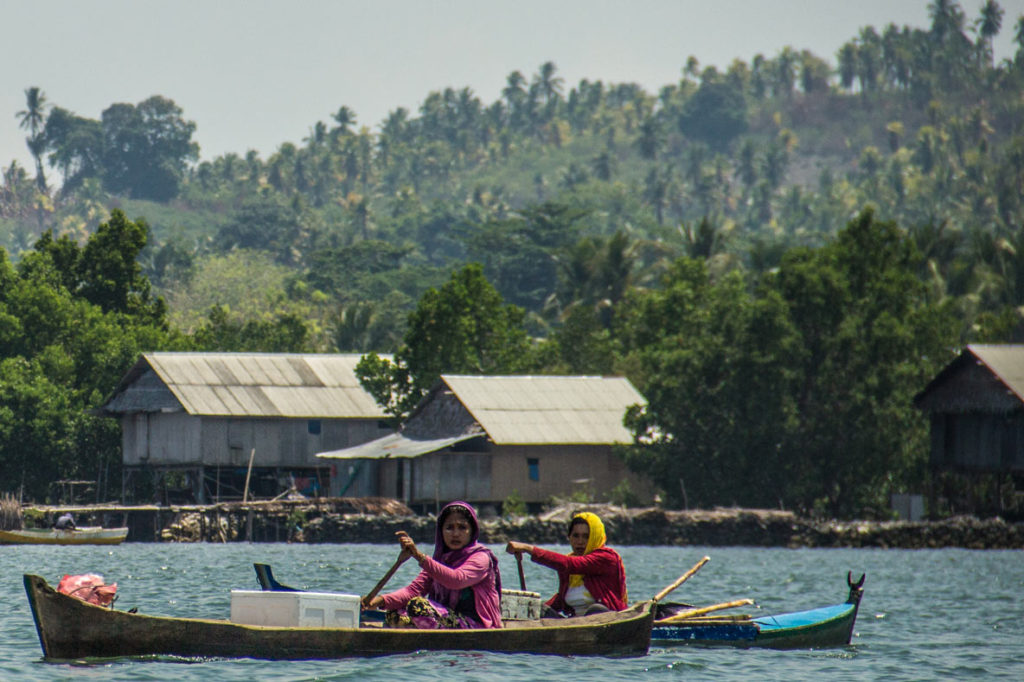
Today on international women’s day 2018 we collectively acknowledge and celebrate women’s achievements throughout history and across nations. It is also known as the United Nations (UN) Day for Women’s Rights and International Peace. Absolutely a day for shared and international celebration. Throughout history and across the world women have fought and continue to fight for equality. We are the individuals, mothers, grandmothers, great grandmothers, sisters, aunties and wives who support ourselves, our families, our friends, our countries and our planet for the most part with quiet affection and definitely not for reasons of recognition or wider acknowledgement. But it is important to recognise and acknowledge the role and achievements of all women, particularly those who are the silent backbone of their communities, where neither support nor recognition is widely offered. I could choose any number of amazing women to focus on here but would like to, very briefly, just draw attention to the women who play a significant yet quiet role in the world’s fisheries. Women play a significant role in fisheries across the globe Women (and children) are key providers for their families and communities across the globe though the work they do gathering seafood for food and for income. The fisheries involving women and children are generally low tech with minimal or no gear often where seagrass and reef flats are ‘gleaned’ by hand at low tide to collect valuable invertebrates (and sometimes fish) for food and for sale. These women and these fisheries remain ill acknowledged and unsupported by local, regional or international efforts to manage and maintain the sense of food security that they convey. But they make up a significant proportion of the small-scale artisanal fisheries that collectively contribute up to one quarter of the total global catch. These women work tirelessly to maintain a way of life or simply to provide protein and nutrition for their families. These are voices that need to be heard and have a significant role to play in the management and maintenance of local scale fisheries. A woman gleans at low tide in Indonesia These often ignored fishers can teach us all a lot about a lot of things, their ecological knowledge, dedication and hard work is something we could all learn from. So this year I would like to celebrate and acknowledge these women on this important day. I would also like to acknowledge and celebrate the amazing women who have always worked hard, led by example, encouraged (without question) and helped shape my own life (‘no matter what’). I am privileged to have and to have had these women in my life. Happy International Women’s Day!
A Symphony For Scottish Seagrass
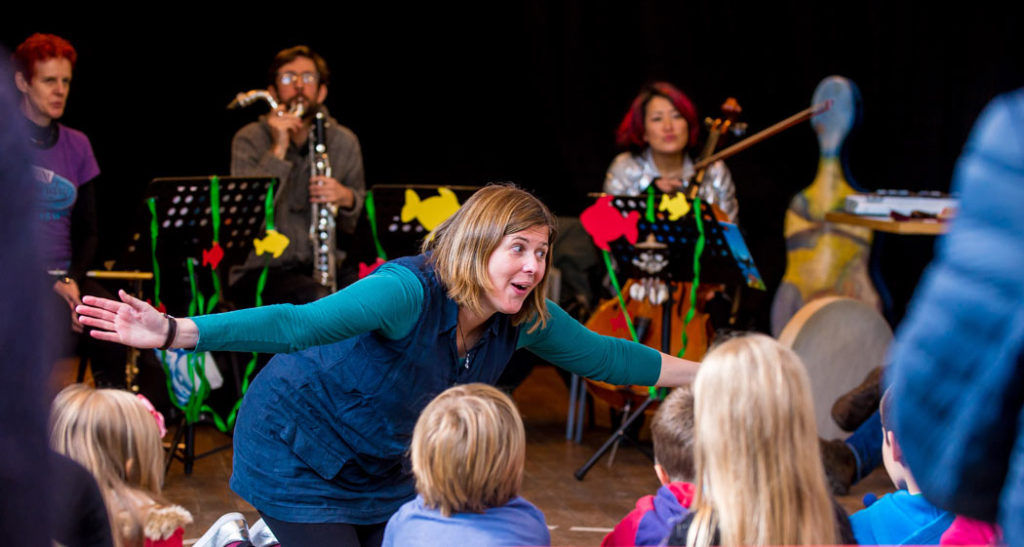
Hello Team Seagrass! I am Rufus, a volunteer with Project Seagrass and a marine biology graduate from the University of St Andrews. Since graduating in June 2017, I have begun working for the Scottish Chamber Orchestra’s Connect team and the University of St Andrews’ Music Centre. In this split position, I get to enjoy the benefits of working with extraordinary artists and musicians across the country to inspire babies, toddlers, children, students and adults to get more involved with the music in the community around them. There are so many educational opportunities provided by both the Scottish Chamber Orchestra and the University of St Andrews. Through its Connect programme, the Scottish Chamber Orchestra interacts with over 10,000 people each year through a vast array of activities. Both the staff and the musicians of the orchestra are extremely driven to reach new audiences all the time, not only to encourage interaction with music in the future but also, in some cases, to improve quality of life. There are so many educational opportunities that can be provided through music. Photo Credit – Fraser Band The Music Centre at the University St Andrews has also led some fantastic workshops throughout local schools in Fife with some of the excellent artists that come to the town to perform. One of the University’s initiatives that I have been involved in is Music Planet. This is a platform that promotes the combination of the arts with global environmental issues to enhance the power of the message that is conveyed, and also to engage new audiences. Music is a fundamental part of human culture, irrespective of where you come from or what your background is. There aren’t many people who don’t enjoy listening to some form of music, either when they are travelling, working, cooking, cleaning or as any other part of their day. I believe that because of this, music has the most potential in interdisciplinary education. Using music, and getting an audience to be involved with music and music making, will help to engage them with any subject. Music making can help children and adults to engage with any subject. Photo Credit – Fraser Band One of the easiest combinations that can be made is music and nature because, in nature, music is all around anyway. The natural soundscape has endless capabilities that can be tapped into to expand the possibilities of what you are teaching. In March, I will be co-leading a SCO workshop, with SCO violin Aisling O’Dea, for primary schools in Fife in conjunction with Project Seagrass and Music Planet from the University of St Andrews. A team of musicians from the orchestra and volunteers from Project Seagrass will provide a day workshop for pupils at primary schools centered around the children’s story, “The Snail and the Whale” by Julia Donaldson. This excellent book tells the story of a snail that seeks to see the world and journeys across the oceans on the tail of a humpback whale. In the end, it is an endearing story of community and self-worth. In March, I will be co-leading a SCO workshop, with SCO violin Aisling O’Dea, for primary schools in Fife in conjunction with Project Seagrass and Music Planet from the University of St Andrews. Photo Credit – Fraser Band The day will be centered around this story’s characters and the music that was written to accompany the story. Various activities throughout the day will involve the children in the scientific background behind important environmental issues whilst providing them the opportunity to get involved with the music making themselves. At this important tipping point, the future of the planet as we know it relies on the engagement of the public all over the world. Music can help to broaden the prospects of domestic and international education campaigns to make that change. Rufus If you would like to follow more of my activity, I have recently started a personal challenge and campaign to reduce my impact on the environment – #Green18. In my attempt to complete this challenge, I will write regular blog posts to document my success and any obstacles I have encountered along the way. Follow online @ www.green18.org Facebook @ www.facebook.com/GreenEighteen/ Instagram @ www.instagram.com/_green_18/ Twitter @ www.twitter.com/_Green_18 You can find out more about the Scottish Chamber Orchestra or music in St Andrews below: Follow online: st-andrews.ac.uk/music/ sco.org.uk Like on Facebook: www.facebook.com/scottishchamberorchestra/ www.facebook.com/UniversityofStAndrewsMusicCentre/ Follow on Twitter: @SCOmusic @StAndrewsMusic

